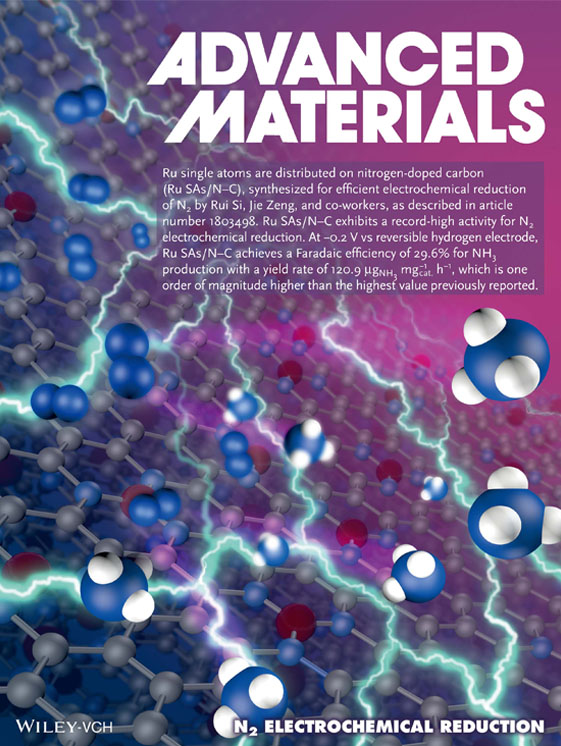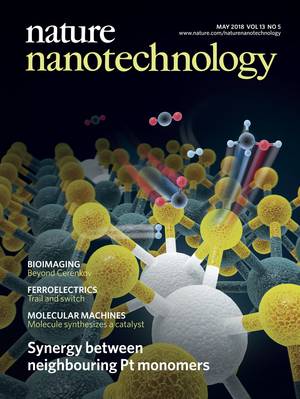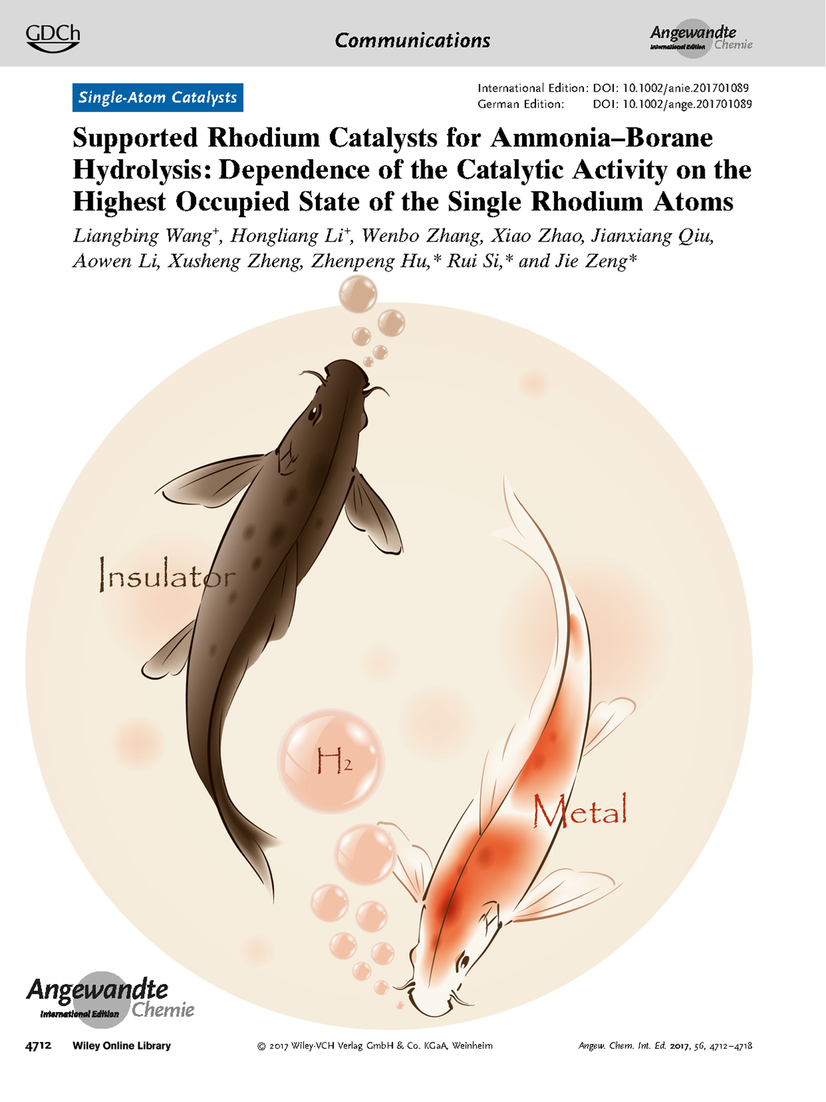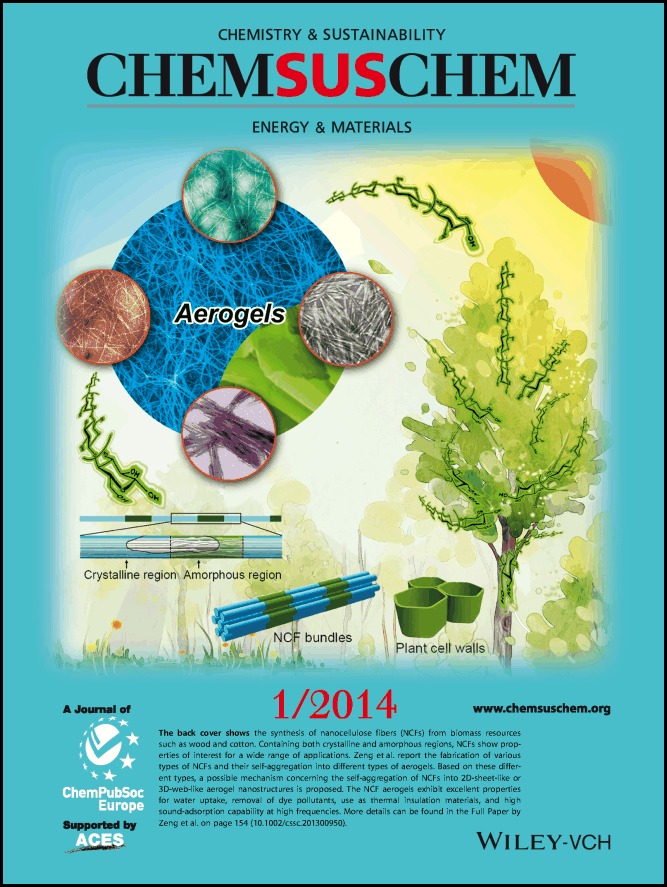 |
This frontispiece was designed by Lei Chen and Yan Liu for an article published in Adv. Mater. (Volume 30, Issue 40. October 4, 2018). The cover is an artist’s depiction of efficient N2 electrochemical reduction to ammonia by Ru single-atom catalysts. The wine red sphere (Ru atoms) was uniformly distributed on nitrogen-doped carbon (blue represents for N and gray represents for C). With the help of electricity, the nitrogen was successfully reduced into ammonia (white represents for H). |
 |
This cover was designed by Guoyan Wang and Yanbing Ma for an article published in Nature Nanotechnol. (Volume 13, Issue 5. May, 2018). The cover is an artist's depiction of CO2 hydrogenation to methanol via synergy between neighbouring Pt monomers. The curved surface represents the MoS2 surface decorated with different types of neighbouring Pt monomer. The yellow sphere (S atom) between neighbouring white spheres (Pt atoms) is shining, as a reflection of a synergetic interaction. |
 |
This cover was designed by Yilun Ding for an article published in Angew. Chem. Int. Ed. (Volume 56, Issue 17. April 18, 2017). It shows the dependence of hydrogen production on metal-insulator phase transition, where the red fish as a representative of metallic support exhales more hydrogen bubbles than the dark one for insulator. The catalytic performance in ammonia borane hydrolysis was directly correlated with the highest occupied state of Rh single atoms, which was determined by the band structure of supports. |
 |
This cover was designed by Lin Lin for an article published in Angew. Chem. Int. Ed. (Volume 55, Issue 33. August 8, 2016). It shows the lightning conductors with a sharp tip to attract lightning, reflecting the sharp-tip effect in the macroscopic world. Pt3Co octapods were the most efficient catalysts for CO2 hydrogenation owing to the presence of multiple sharp tips (the“sharp-tip effect”) and charge transfer between Pt and Co, which leads to the accumulation of negative charge in the vertices. |
 |
This cover was designed by Yunqian for an article published in Part. Part. Syst. Charact. (2014, 31, 597). It shows how N dopants are tailored in the form of both substitutional and pyrrolic N in graphene quantum dots (N-GQDs), showing controllable chemical properties. The substitutional N leads to significantly modified photoluminescence properties of the versatile N-GQDs, which also exhibit highly efficient photocurrent conversion abilities when supported by anatase nanofibers. |
 |
This cover was designed by Wenshuai for an article published in ChemSusChem (2014, 7, 154). It shows the synthesis of nanocellulose fibers (NCFs) from biomass resources. The NCF aerogels exhibit excellent properties for water uptake, removal of dye pollutants, use as thermal insulation materials, and high sound-adsorption capability at high frequencies. |
 |
This cover was designed by Yiqun for an article published in Chem. Asian J. (2013, 8, 792). It shows the gold nanospheres with diameters precisely controlled in the range of 5–30 nm were synthesized using a successive, seed-mediated growth. The gold nanospheres were found to self-assemble into dimers, larger aggregates, and wavy nanowires when they were diluted to different volumes with deionized water. |
 |
This cover was designed by Xiaohu for an article published in J. Phys. Chem. C (2012, 116, 21647). It shows silver nanocrystals of different shapes grown from cuboctahedral seeds (center). Poly(vinyl pyrrolidone) (left) and citrate (right) selectively bind to Ag(100) and Ag(111) surfaces, respectively, and thus favor the formation of Ag nanocrystals enclosed preferentially by {100} or {111} facets. A series of Ag nanocrystals with controlled shapes and sizes can be synthesized by using different combinations of capping agents and seeds. |
 |
This cover was designed by Jie for an article published in ChemCatChem (2012, 4, 1668-1674). It shows that Pd–Au bimetallic nanocrystals with a number of different morphologies, including hybrid dimers, core–shell nanocubes with flat faces, and core–shell nanocubes with concave faces, could all be synthesized by controlling the growth mode of Au on Pd cubic seeds. The high-index facets associated with a concave surface can potentially enhance the performance of Au-based nanocatalysts in a range of industrially important reactions. |
 |
This cover was designed by Jianhua & Jie for an article published in Small (2011, 7, 3308-3316). It shows an on-chip approach to the rapid screening of experimental conditions pivotal to the production of nanostructures with different morphologies. By taking advantages of microfluidics, this approach uses an array of reactors containing solutions with a 1D or 2D gradient in reagent concentration, pH value, or reaction temperature. |


